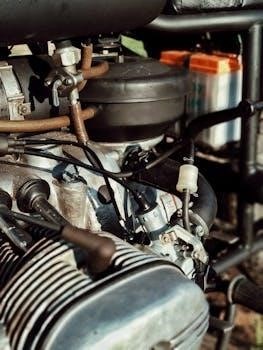Cessna 150 parts manuals are essential resources for aircraft maintenance. They detail every component, aiding in repairs and replacements. These manuals provide necessary diagrams and part numbers, ensuring correct part ordering and installation.
Importance of the Parts Manual
The parts manual is critical for maintaining the Cessna 150, acting as a detailed guide for identifying and sourcing the correct components. Without it, accurately repairing or replacing parts is extremely challenging, potentially leading to costly errors and downtime. These manuals offer precise diagrams and part numbers, essential for ensuring that each component is the correct fit and specification. They are vital for mechanics and aircraft owners alike, providing a clear path to proper maintenance and ensuring the aircraft’s continued airworthiness. Using the manual accurately is of crucial importance when ordering replacement components, as they serve as the ultimate authority for parts identification, as well as compatibility. Additionally, having the parts manual can also help with preventative maintenance, allowing for timely replacement of worn components, thus enhancing the overall lifespan and safety of the aircraft. Ultimately, the parts manual serves as a critical tool for aircraft upkeep.
Overview of Cessna 150 Models
The Cessna 150 series, produced from 1959 to 1977, encompasses various models, each having slight differences in components. Understanding these variations is vital when consulting a parts manual. Early models may differ significantly from later ones, affecting compatibility of certain parts. For example, a 1964 model’s baffle system could differ from a 1977 one. Identifying the specific model is crucial before ordering parts. The Cessna 150 was available in several variants, including the 150A, 150B, and so on, culminating in the 150M. Each modification could include changes to the airframe, engine, or electrical systems. Variations also exist in the French-produced models, which may have different part number usage. Therefore, always refer to the specific model’s parts manual to ensure accuracy. Using an incorrect part could lead to serious issues. It is imperative to know the precise year and model of your aircraft.

Key Components and Systems
The Cessna 150’s key systems include the airframe, engine, and electrical components. These systems contain numerous parts, meticulously detailed in the parts manual for maintenance and repair purposes.
Airframe Components
The airframe of the Cessna 150 is constructed from various components, each vital for its structural integrity and flight performance. These components include the wing assembly, which provides lift, and the vertical fin and rudder, essential for directional control. The parts manual offers detailed diagrams and part numbers for each of these components, facilitating accurate replacements and repairs. Specific items like the unpainted top cap of the vertical fin, with part number 0431013-3, are listed, as are complete assemblies like the right wing assembly, example part number 0422402-2. The manual also covers fiberglass replacement parts for the rudder and vertical fin caps, noting that these are stronger than the original factory parts. Information on dorsal tips and other structural elements is included, ensuring that any maintenance or repairs are carried out with precision and using the correct parts. These components are meticulously cataloged in the parts manual, ensuring that mechanics have all necessary information at their fingertips.
Wing Assembly
The wing assembly of the Cessna 150 is a critical component, responsible for generating lift. The parts manual provides detailed information on all parts within this assembly, including ribs, spars, and skins. Specific part numbers, such as 0422402-2 for the right wing assembly, are listed, allowing for accurate identification and replacement. The manual also covers various smaller components, from leading edges to trailing edges, ensuring that no part is overlooked during maintenance. Fiberglass replacement parts for wing tips are also included, with information highlighting their enhanced strength compared to original parts. Detailed diagrams and exploded views within the manual offer mechanics a clear understanding of how each component fits together. This level of detail is critical for proper maintenance and safe operation of the aircraft. Understanding the specific parts within the wing assembly is crucial for any repair or replacement work.
Vertical Fin and Rudder
The vertical fin and rudder assembly provides crucial directional stability for the Cessna 150. The parts manual meticulously details each component, such as the fin cap, rudder itself, and associated hardware. Part numbers like 0431013-3 for the unpainted top cap are readily available, facilitating accurate ordering. The manual specifies different variations of parts based on model year, ensuring the correct fit. Furthermore, fiberglass replacement options for fin caps and rudder are often highlighted as stronger alternatives to the originals. The manual includes diagrams showing the precise arrangement of all components, from hinges to control linkages. Understanding these details is paramount for proper maintenance and repairs. These sections also cover replacement options and necessary hardware for a correct installation. Accurate identification of parts within this assembly is essential for the safe operation of the aircraft. The manual ensures that technicians are equipped with all the necessary information.
Engine and Baffle Components
The engine and baffle components section of the Cessna 150 parts manual is crucial for maintaining the aircraft’s powerplant. This area covers various parts associated with the Lycoming engine, such as cylinders, pistons, and the carburetor. The manual also includes detailed information on the engine baffle system, which plays a vital role in engine cooling. Replacement baffle components are often available from manufacturers like Airforms, offering FAA-PMA approved parts. The manual provides specific part numbers for each item, ensuring accurate ordering. Diagrams in this section show the layout of the engine and the arrangement of baffles, aiding in proper installation; Detailed illustrations allow mechanics to easily identify all components. This section is essential for engine maintenance and repair, ensuring the safe and efficient operation of the aircraft. Proper cooling, facilitated by well-maintained baffles, is vital for the engine’s longevity.
Lycoming Engine Parts
The Lycoming engine parts section within a Cessna 150 parts manual is exceptionally detailed, covering every component of the aircraft’s engine. This includes items like the crankshaft, camshaft, connecting rods, and valves. The manual provides specific part numbers for each component, facilitating accurate ordering and replacement. Illustrated diagrams are included to show the precise location and assembly of each part. The information is critical for maintenance and repair, ensuring that only correct parts are used. The Lycoming IO-360-L2A illustrated parts catalog, for example, offers comprehensive details on engine components. Proper maintenance using the correct parts from the manual is essential for the safe and reliable operation of the Cessna 150. This section helps mechanics understand the engine’s intricate workings. Referencing this section ensures optimal engine performance and longevity.
Engine Baffle Replacements
The engine baffle replacement section in a Cessna 150 parts manual is crucial for maintaining proper engine cooling. These baffles direct airflow around the engine cylinders, preventing overheating. The manual will list various baffle components, including those for different series of Cessna 150 models, such as the 1964-70 and 1971-77 series. Detailed diagrams and part numbers help in identifying the correct replacements. Airforms is noted as a manufacturer of FAA-PMA replacement baffle components, suggesting high-quality alternatives. Baffle replacements are vital for engine health, and the manual ensures mechanics can source the appropriate parts. This section addresses the specific needs of the engine cooling system. The information helps prevent engine damage by ensuring proper airflow. Correct baffle installation ensures optimal performance.

Electrical System and Lighting
The electrical system and lighting section of the Cessna 150 parts manual provides details on components like wiring, switches, and, of course, lighting. This section is critical for ensuring the safe operation of the aircraft. Specifically, the manual covers lighting components, such as the PAR36 style light used in the Cessna 150. This part ensures proper visibility and is essential for flight safety. The manual also lists part numbers and diagrams for the various electrical components; This makes it easier for mechanics to locate and replace faulty parts. Correct wiring diagrams and component specifications are necessary for maintaining the electrical system. This section of the manual helps in troubleshooting and repairing any electrical issues. Maintenance of these systems is paramount for safe and reliable flight operations. Proper lighting is vital for night flying and visibility in various conditions. The manual ensures all systems are maintained correctly.
PAR36 Style Light
The Cessna 150 utilizes a PAR36 style light, which is crucial for visibility during flight, particularly in low-light conditions. The parts manual provides detailed specifications for this light, including its part number, dimensions, and electrical requirements. This information is essential for ordering the correct replacement part. The manual also includes diagrams showing the light’s mounting location and wiring connections. This ensures proper installation and functionality. The PAR36 light is a key component of the aircraft’s lighting system, contributing to flight safety. Understanding the specifications helps in proper maintenance and replacement. The manual includes all details that are needed to ensure that the light is working as intended. This includes checking for proper illumination and wiring issues. The light is very important for night flights. The parts manual ensures proper replacement when needed. It details all aspects of the PAR36 light. Ensuring correct maintenance is essential for safety.

Accessing and Using Parts Manuals
Cessna 150 parts manuals are available in various formats, including digital and printed. Understanding part numbers and diagrams is key to effectively using these essential resources for maintenance.
Availability of Manuals
Cessna 150 parts manuals are widely accessible, catering to the needs of aircraft owners and maintenance professionals. These manuals can often be found in both digital and printed formats, offering flexibility in how they are used. Online resources, such as dedicated aviation websites and forums, frequently provide access to downloadable PDF versions of these manuals. Furthermore, many aviation supply companies and vendors offer printed copies of the Cessna 150 parts catalogs. It is important to ensure that you are using the correct manual for your specific aircraft model and year, as there may be variations. Moreover, some manuals are tailored to specific engine types or configurations. Therefore, consulting multiple sources can be beneficial to guarantee you have the most comprehensive and accurate information. Remember to always verify the authenticity of the manual before relying on it for maintenance or repair work.
Understanding Part Numbers and Diagrams
Navigating Cessna 150 parts manuals requires a clear understanding of part numbers and accompanying diagrams. Part numbers are unique identifiers that specify the exact component needed for your aircraft. These numbers are often alphanumeric and follow a specific format defined by Cessna. Diagrams, typically illustrated, provide a visual representation of the part’s location and how it relates to other components within the system. The diagrams are crucial for understanding assembly and disassembly procedures. Furthermore, exploded views are commonly used to show how parts fit together. Learning how to interpret these diagrams and associated part numbers is essential for accurate part identification and replacement. Proper interpretation will minimize errors, ensuring the correct part is ordered, installed, and maintained. Incorrect part identification could lead to improper functioning or even damage to the aircraft. Therefore, familiarity with these diagrams and part numbering systems is paramount for safe and effective aircraft maintenance.

Additional Resources and Information
Besides parts manuals, maintenance and repair manuals are crucial for Cessna 150 upkeep. Pre-flight and operational procedure guides ensure safe aircraft operation and handling.
Maintenance and Repair Manuals
Complementing the parts manuals, maintenance and repair manuals are indispensable for Cessna 150 owners and mechanics. These detailed guides provide step-by-step instructions for various maintenance tasks, from routine inspections to complex repairs. They often include detailed diagrams and troubleshooting tips, ensuring accurate and safe procedures. These manuals are crucial for maintaining the aircraft’s airworthiness and extending its lifespan. They address both airframe and engine maintenance, ensuring comprehensive coverage. Using these manuals correctly helps to avoid costly mistakes and ensures that all work is carried out to the appropriate standards. They include torque specifications, component removal, and installation procedures. Furthermore, they often reference relevant service bulletins and airworthiness directives. Accessing the correct maintenance manual for your specific Cessna 150 model is key to proper upkeep.
Pre-Flight and Operational Procedures
While not directly part of a parts manual, understanding pre-flight and operational procedures is crucial for safe Cessna 150 operation. These procedures are detailed in the aircraft’s Pilot Operating Handbook (POH). They outline essential checks before each flight, including control surface movement, fuel levels, and engine operation. This ensures the aircraft is in safe working condition. The POH provides checklists for start-up, taxiing, takeoff, cruise, and landing, as well as emergency procedures. These procedures must be followed rigorously to minimize risk. Familiarity with these procedures enhances safety and reduces the likelihood of mechanical issues developing during flight. Proper understanding of these procedures is as important as having the correct parts and their respective manuals. They should be used in conjunction with maintenance records for a complete safety profile. Therefore, regular review of the POH is essential for all Cessna 150 pilots.
